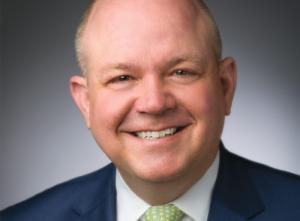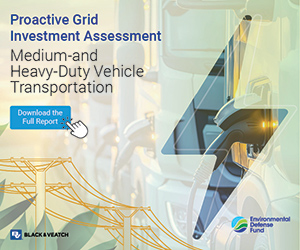CenterPoint Energy
Jason Ryan is senior vice president, Regulatory Services and Government Affairs for CenterPoint Energy.
How do today's natural gas utilities find the right balance, rigorously addressing ESG priorities while continuing to meet the needs of the communities they serve via gas utility service? In the conversations below, leaders from CenterPoint Energy, Eversource, NiSource, NW Natural, and Sempra Energy (both at San Diego Gas & Electric and at the parent) take on directly how they are managing that balance.

PUF's Steve Mitnick: At CenterPoint Energy, what are the biggest stories about what you all are doing in the ESG area?
Jason Ryan: We are the first utility with electric generation to announce a net zero carbon goal for Scope 1 and 2 greenhouse gas emissions by 2035, which is a full fifteen years ahead of our peers' average goals. We're also the first utility to announce Scope 3 carbon reduction goals by 2035 that apply to all of our operating jurisdictions across a multi-state footprint. That puts us ahead of our peers on both the electric and the natural gas side.
Scope 1 and 2 emissions are direct and indirect emissions. Scope 1 is the most direct emissions, like power plants. For Scope 2, it would be emissions from, for example, all our own buildings and the energy they consume.
Scope 3 are mostly our end-use consumer emissions. On the natural gas side of our business, most of the emissions are Scope 3. It's the emissions at the customer's burner tip.
PUF: Why did you decide to go this way and how were you able to pull this off, practically speaking?
Jason Ryan: These goals are all doable, but I'll focus on the Scope 3 goal since it's the most unique in our industry. Currently underway, we have significant energy efficiency programs. You can reduce emissions in a number of different ways. One important place to start is by having customers use less of what you're selling.
Another is that we also have several hydrogen pilots underway throughout our footprint, so we're adding hydrogen to our pipes with the traditional methane. Hydrogen will reduce emissions.
Third, we've got carbon sequestration projects underway with some commercial customers. Our established programs are already starting to address Scope 3 emissions.
Going forward, we've got specific actions that we can take to continue to make progress toward our Scope 3 goal by 2035. This includes renewable natural gas, more energy efficiency and weatherization programs, and continued use of hydrogen in our system. You can mix renewable natural gas, you can mix hydrogen with traditional methane, and use the infrastructure that's there already.
PUF: There's been talk over the years about energy efficiency, but you are doing it. Give some more information on that.
Jason Ryan: I will not claim that we were the first natural gas utility to be aggressive on energy efficiency programs, but we have had them in a number of our states for many years now. There is always an opportunity to do more to expand that initiative.
That is a way to make the biggest emissions reduction, by reducing the amount of what causes the emissions when it's being used by the customer. That's a good place for us to continue to ramp up.
PUF: The technologies on hydrogen are developing, but you're hard at work.
Jason Ryan: CenterPoint Energy promotes a culture of innovation and continuous improvement. We're in early stages of our experience with hydrogen, but it's important that we're at least in those early stages. We're not still waiting to start. We will learn more over time on how to best put that technology to use for the benefit of our customers and for reducing carbon emissions at the same time.
PUF: Why are you all not just studying hydrogen, but pursuing it aggressively?
Jason Ryan: I'll address it separately from the increasing focus on ESG to also point out that a lot of our energy efficiency programs are cost-effective measures in and of themselves. We have those programs to help reduce the cost to our customers.
That creates headroom in our rates that also allows us to make additional investments without increasing the overall bill. We look for those energy efficiency programs that have a net benefit to customers from a cost perspective, could reduce the bill, and then allow us to spend that money on more innovation on behalf of our customers. That could be on renewable natural gas or hydrogen, and additional safety-related spend.
It makes it more affordable for our customers. The fact that we're also lining up well with what investors and others expect of us is good, but there's also a significant customer benefit behind a lot of this.
PUF: You're in more than one state. How do you deal with that and try to make everybody happy?
Jason Ryan: We have the privilege to serve about four and a half million homes and businesses with our natural gas operations, from Minnesota down to Texas, and a lot of important communities in between.
On the electric side, we have electric utilities in Texas and Indiana serving about 2.7 million homes and businesses. Across all of these states, there are different weather climates, and different political climates.
In Minnesota, during this past legislative session, there was a bipartisan Natural Gas Innovation Act that we supported and that was ultimately passed. That provided a framework for the Minnesota Public Utilities Commission to address innovations in natural gas service, like renewable natural gas, carbon sequestration, hydrogen, and whatever technology comes next.
I highlight that act as an accomplishment for our business and our customers because Minnesota is the one state in the country that has a divided legislature, meaning one party controls one chamber and the other party controls the other.
In Minnesota, Republicans have the majority in the Senate and Democrats have the majority in the House. To pass comprehensive energy policy in a bipartisan way was a big, important goal of ours.
We have figured out how to talk about this in a way that makes sense without getting bogged down in the politics of it, to move policy forward to benefit our customers.
PUF: What kind of feedback are you getting from the community?
Jason Ryan: We are fortunate to serve many growing areas of our country — Texas saw fifteen percent population growth in the last decade, Minnesota was around eight percent. Their growth is outpacing the average.
In Indiana, it's about five percent, which is significant as well. As we talked about the Natural Gas Innovation Act in Minnesota, more broadly, our stakeholders view the importance of natural gas as an affordable energy source.
They are supportive of us having these conversations and us leading in this area so we can continue to make sure natural gas remains an affordable energy source for our customers and communities, to address carbon emissions in a thoughtful and affordable way. Even in oil and gas producing states, these are issues that need to be addressed.
PUF: ESG has three letters to it. There's the E, which is important, particularly for our industry because a lot of people are looking at it. What's going on with S and G at CenterPoint Energy?
Jason Ryan: For G, we've enhanced our governance here recently to align to ESG best practices. We've got an independent chair now, which again, if you look at our peers, is not universally true. We have a board committee that just became the Governance, Environmental and Sustainability Committee. It was our prior governance committee.
They will be holding us accountable as it relates to our management's ESG plan. Environmental measures will be put into executive compensation starting next year, and we have a vice president in charge of environment and corporate sustainability.
As it relates to diversity on our board, our current board is fifty-five percent women or minorities, and sixty-six percent of our board has been appointed in the last five years. We stack up well compared to our peers from a governance perspective.
As it relates to the S of ESG, we've made a lot of progress over the last year to eighteen months when it comes to diversity, equity, and inclusion. We've taken a number of actions, including more formalized employee resource groups.
We've started talking more about diversity and inclusion, particularly around inclusion. And we've always been strong supporters of good causes in our communities. At least ten percent of the CenterPoint Energy Foundation's annual budget supports our Diversity and Inclusion giving strategy
You can have a diverse workforce, and all be separate; that's where our continued work on inclusion comes in. We have a lot of work ahead of us, driven by our employees who are helping create and develop these employee resource groups. The fact that we're talking about it more is a good start to address the issues around diversity and inclusion.
PUF: How does the company, and you in your work integrate ESG into the other things you do?
Jason Ryan: The way we're approaching our business is we want to be sustainable and affordable for our customers, we want to have sustainable growth for our shareholders, and we want to be sustainable in terms of our impact on our environment.
We are looking at it through that sustainability lens in all aspects of the business. When you look at it that way, even though you might think there could be a divergence in terms of one of those three paths, that brings it all together and helps us have one unified look going forward as a sustainable utility in all the ways that sustainability could be defined.
ESG Naturally conversations:



